Urban Human Settlement Vulnerability Evolution and Mechanisms: The Case of Anhui Province, China
Abstract
1. Introduction
2. Overview of the Study Area and Data Sources
2.1. Overview of the Study Area
2.2. Data Sources
2.3. Data Retrieval and Input
3. Research Methods
3.1. Construction of Human Settlement Vulnerability Assessment Index System
3.1.1. CRITIC Indicator Weight Calculation
3.1.2. Exposure
3.1.3. Sensitivity
3.1.4. Coping Ability
3.2. Human Settlement Vulnerability Index
3.3. Pearson’s Correlation Analysis Method
3.4. Geodetector
4. Evolution Characteristics of Human Settlement Vulnerability in Anhui Province
4.1. Spatial Structure Evolution of the Human Settlement Vulnerability Subsystems
4.1.1. The Evolution of the Human Settlement Vulnerability Subsystems Showed the Direction of “Medium–High–Low (M-H-L)” in the Early Stage
4.1.2. The Evolution of the Human Settlement Vulnerability Subsystems Showed the Direction of “Low–High–Medium (L-H-M)” in the Middle Stage
4.1.3. The Later Evolution of the Human Settlement Vulnerability Subsystems Showed the Direction of “Low–Medium–High (L-M-H)”
4.1.4. Overall Trend of the Evolution of the Human Settlement Vulnerability Subsystems
4.2. Characteristics of the Spatio-temporal Evolution of Human Settlement Vulnerability
4.2.1. Timescale Changes in Human Settlement Vulnerability in Anhui Province in Main Years
4.2.2. Spatial Scale Changes in Human Settlement Vulnerability in Anhui Province in Main Years
5. The Driving Mechanism of the Evolution of Human Settlement Environment Vulnerability in Anhui Province
5.1. Correlation Analysis of Human Settlement Vulnerability Subsystem
5.2. Analysis of Influencing Factors of Evolution of Human Settlement Vulnerability
5.2.1. Differentiation of Human Settlement Vulnerability and Factor Detection
5.2.2. Interaction Detection of Human Settlement Vulnerability Factors
5.3. Analysis of the Evolution Mechanism of Human Settlement Vulnerability
5.3.1. Impact of Industrialization and Urbanization on the Vulnerability of Human Settlements
5.3.2. The Impact of Government Land Use Regulation on the Vulnerability of Human Settlements
5.3.3. Impact of Raising per Capita Income Levels on Human Settlement Vulnerability
6. Discussion
7. Conclusions
Author Contributions
Funding
Data Availability Statement
Conflicts of Interest
References
- Chen, J. Temporal-spatial assessment of the vulnerability of human settlements in urban agglomerations in China. Environ. Sci. Pollut. Res. 2022, 30, 3726–3742. [Google Scholar] [CrossRef] [PubMed]
- Salami, R.O.; von Meding, J.K.; Giggins, H. Vulnerability of human settlements to flood risk in the core area of Ibadan metropolis, Nigeria. Jàmbá J. Disaster Risk Stud. 2017, 9, 14. [Google Scholar] [CrossRef] [PubMed]
- Angarita Uscategui, P.N.; Gallardo Amaya, R.J.; Oliva Gonzalez, A.O. Analysis of urban vulnerability before natural and anthropogenic hazards: Case study, human settlement Colinas de la provincia, municipality of Ocaña, Colombia. J. Phys. Conf. Ser. 2019, 1257, 012020. [Google Scholar] [CrossRef]
- Zhang, Z.; Xiao, R.; Shortridge, A.; Wu, J. Spatial point pattern analysis of human settlements and geographical associations in eastern coastal China—A case study. Int. J. Environ. Res. Public Health 2014, 11, 2818–2833. [Google Scholar] [CrossRef] [PubMed]
- Yang, N.; Cui, J. Research on the application of neural network based external location element settlement method in object location of geographic information. J. King Saud Univ.-Sci. 2022, 35, 102463. [Google Scholar] [CrossRef]
- Li, X.; Li, S.; Gao, J.; Zhao, P.; Li, H. Human Settlement Quality Evaluation Based on Air Quality in Major Cities of China. Adv. Meteorol. 2018, 2018, 4914760. [Google Scholar] [CrossRef]
- Chen, W.; Zhu, K.; Wu, Q.; Cai, Y.; Lu, Y.; Wei, J. Adaptability evaluation of human settlements in Chengdu based on 3S technology. Environ. Sci. Pollut. Res. 2021, 29, 5988–5999. [Google Scholar] [CrossRef]
- Wang, P.; Qin, X.; Li, Y. Satisfaction Evaluation of Rural Human Settlements in Northwest China: Method and Application. Land 2021, 10, 813. [Google Scholar] [CrossRef]
- Zhao, Y.; Zhang, J. The Natural Suitability of Human Settlements and Their Spatial Differentiation in the Nenjiang River Basin, China. Front. Environ. Sci. 2022, 10, 270. [Google Scholar] [CrossRef]
- Xue, Q.; Yang, X.; Wu, F. A two-stage system analysis of real and pseudo urban human settlements in China. J. Clean. Prod. 2021, 293, 126272. [Google Scholar] [CrossRef]
- Zhou, C.; Zhang, D.; Cao, Y.; Wang, Y.; Zhang, G. Spatio–temporal evolution and factors of climate comfort for urban human settlements in the Guangdong–Hong Kong–Macau Greater Bay Area. Front. Environ. Sci. 2022, 10, 1001064. [Google Scholar] [CrossRef]
- Jiang, Y.; Chen, M.; Zhang, J.; Sun, Z.; Sun, Z. The improved coupling coordination analysis on the relationship between climate, eco-environment, and socio-economy. Environ. Ecol. Stat. 2021, 29, 77–100. [Google Scholar] [CrossRef]
- Melchiorri, M.; Florczyk, A.; Freire, S.; Schiavina, M.; Pesaresi, M.; Kemper, T. Unveiling 25 Years of Planetary Urbanization with Remote Sensing: Perspectives from the Global Human Settlement Layer. Remote Sens. 2018, 10, 768. [Google Scholar] [CrossRef]
- Nepal, S. Tourism and Remote Mountain Settlements: Spatial and Temporal Development of Tourist Infrastructure in the Mt Everest Region, Nepal. Tour. Geogr. 2005, 7, 205–227. [Google Scholar] [CrossRef]
- Ouzounis, G.K.; Syrris, V.; Pesaresi, M. Multiscale quality assessment of Global Human Settlement Layer scenes against reference data using statistical learning. Pattern Recognit. Lett. 2013, 34, 1636–1647. [Google Scholar] [CrossRef]
- Van Den Hoek, J.; Friedrich, H.K. Satellite-Based Human Settlement Datasets Inadequately Detect Refugee Settlements: A Critical Assessment at Thirty Refugee Settlements in Uganda. Remote Sens. 2021, 13, 3574. [Google Scholar] [CrossRef]
- Wang, Q.; Wang, H. Evaluation for the spatiotemporal patterns of ecological vulnerability and habitat quality: Implications for supporting habitat conservation and healthy sustainable development. Environ. Geochem. Health 2022, 6, 1–31. [Google Scholar] [CrossRef]
- Pasquini, L.; van Aardenne, L.; Godsmark, C.N.; Lee, J.; Jack, C. Emerging climate change-related public health challenges in Africa: A case study of the heat-health vulnerability of informal settlement residents in Dar es Salaam, Tanzania. Sci. Total Environ. 2020, 747, 141355. [Google Scholar] [CrossRef] [PubMed]
- Song, F.; Yang, X.; Wu, F. Suitable Pattern of the Natural Environment of Human Settlements in the Lower Reaches of the Yangtze River. Atmosphere 2019, 10, 200. [Google Scholar] [CrossRef]
- Olokeogun, O.S.; Kumar, M. An indicator based approach for assessing the vulnerability of riparian ecosystem under the influence of urbanization in the Indian Himalayan city, Dehradun. Ecol. Indic. 2020, 119, 106796. [Google Scholar] [CrossRef]
- Weiss, M.; Jacob, F.; Duveiller, G. Remote sensing for agricultural applications: A meta-review. Remote Sens. Environ. 2020, 236, 111402. [Google Scholar] [CrossRef]
- Halder, B.; Bandyopadhyay, J.; Khedher, K.M.; Fai, C.M.; Tangang, F.; Yaseen, Z.M. Delineation of urban expansion influences urban heat islands and natural environment using remote sensing and GIS-based in industrial area. Environ. Sci. Pollut. Res. 2022, 29, 73147–73170. [Google Scholar] [CrossRef]
- Cetin, M. The effect of urban planning on urban formations determining bioclimatic comfort area’s effect using satellitia imagines on air quality: A case study of Bursa city. Air Qual. Atmos. Health 2019, 12, 1237–1249. [Google Scholar] [CrossRef]
- Chen, F.; Chen, X.; Van de Voorde, T.; Roberts, D.; Jiang, H.; Xu, W. Open water detection in urban environments using high spatial resolution remote sensing imagery. Remote Sens. Environ. 2020, 242, 111706. [Google Scholar] [CrossRef]
- Sebesvari, Z.; Renaud, F.G.; Haas, S.; Tessler, Z.; Hagenlocher, M.; Kloos, J.; Szabo, S.; Tejedor, A.; Kuenzer, C. A review of vulnerability indicators for deltaic social–ecological systems. Sustain. Sci. 2016, 11, 575–590. [Google Scholar] [CrossRef]
- Malekmohammadi, B.; Jahanishakib, F. Vulnerability assessment of wetland landscape ecosystem services using driver-pressure-state-impact-response (DPSIR) model. Ecol. Indic. 2017, 82, 293–303. [Google Scholar] [CrossRef]
- Wang, J.-F.; Hu, Y. Environmental health risk detection with GeogDetector. Environ. Model. Softw. 2012, 33, 114–115. [Google Scholar] [CrossRef]
- Fei, X.; Lou, Z.; Xiao, R.; Ren, Z.; Lv, X. Contamination assessment and source apportionment of heavy metals in agricultural soil through the synthesis of PMF and GeogDetector models. Sci. Total Environ. 2020, 747, 141293. [Google Scholar] [CrossRef]
- Torkayesh, A.E.; Ecer, F.; Pamucar, D.; Karamaşa, Ç. Comparative assessment of social sustainability performance: Integrated data-driven weighting system and CoCoSo model. Sustain. Cities Soc. 2021, 71, 102975. [Google Scholar] [CrossRef]
- Ehrlich, D.; Melchiorri, M.; Florczyk, A.; Pesaresi, M.; Kemper, T.; Corbane, C.; Freire, S.; Schiavina, M.; Siragusa, A. Remote Sensing Derived Built-Up Area and Population Density to Quantify Global Exposure to Five Natural Hazards over Time. Remote Sens. 2018, 10, 1378. [Google Scholar] [CrossRef]
- Yu, J.; Li, F.; Wang, Y.; Lin, Y.; Peng, Z.; Cheng, K. Spatiotemporal evolution of tropical forest degradation and its impact on ecological sensitivity: A case study in Jinghong, Xishuangbanna, China. Sci. Total Environ. 2020, 727, 138678. [Google Scholar] [CrossRef] [PubMed]
- Tan, B.; Wang, H.; Wang, X.; Yi, S.; Zhou, J.; Ma, C.; Dai, X. The study of early human settlement preference and settlement prediction in Xinjiang, China. Sci. Rep. 2022, 12, 5072. [Google Scholar] [CrossRef] [PubMed]
- Gao, Y.; Chen, W. Evolution and Influencing Factors of Township Spatial Form: A Two-Dimensional Perspective. Complexity 2020, 2020, 5617545. [Google Scholar] [CrossRef]
- Zehua, Z.; Yongze, S.; Peng, W. Robust geographical detector. Int. J. Appl. Earth Obs. Geoinf. 2022, 109, 102782. [Google Scholar] [CrossRef]
- Wenyin, W.; Jie, Z.; Zhongyi, S.; Jianan, Y.; Wenjie, L.; Rui, Y.; Peng, W. Attribution analysis of land degradation in Hainan Island based on geographical detector. Ecol. Indic. 2022, 141, 109119. [Google Scholar] [CrossRef]
- Zhao, Y.; Deng, Q.; Lin, Q.; Zeng, C.; Zhong, C. Cadmium source identification in soils and high-risk regions predicted by geographical detector method. Environ. Pollut. 2020, 263, 114338. [Google Scholar] [CrossRef]
- Haipeng, Z.; Hanchu, L.; Yong, S.; Renwei, H. Spatial Differentiation Characteristics of Human Settlements and Their Responses to Natural and Socioeconomic Conditions in the Marginal Zone of an Uninhabited Area, Changtang Plateau, China. Chin. Geogr. Sci. 2022, 32, 506–520. [Google Scholar] [CrossRef]
- Čeplová, N.; Kalusová, V.; Lososová, Z. Effects of settlement size, urban heat island and habitat type on urban plant biodiversity. Landsc. Urban Plan. 2017, 159, 15–22. [Google Scholar] [CrossRef]
- Tong, S.; Zhu, Y.; Li, Z. Correlation Study between Rural Human Settlement Health Factors: A Case Study of Xiangxi, China. Comput. Intell. Neurosci. 2022, 2022, 2484850. [Google Scholar] [CrossRef]
- Wu, F.; Liu, Y.; Zeng, Y.; Yan, H.; Zhang, Y.; Li, L.-H. Evaluation of the Human Settlements Environment of Public Housing Community: A Case Study of Guangzhou. Sustainability 2020, 12, 7361. [Google Scholar] [CrossRef]
- Ye, L.; Wu, Z.; Wang, T.; Ding, K.; Chen, Y. Villagers’ Satisfaction Evaluation System of Rural Human Settlement Construction: Empirical Study of Suzhou in China’s Rapid Urbanization Area. Int. J. Environ. Res. Public Health 2022, 19, 11472. [Google Scholar] [CrossRef] [PubMed]
- Wang, Y.; Miao, Z. Towards the analysis of urban livability in China: Spatial–temporal changes, regional types, and influencing factors. Environ. Sci. Pollut. Res. 2022, 29, 60153–60172. [Google Scholar] [CrossRef] [PubMed]
- Lisha, T.; Hualou, L. Simulating the development of resilient human settlement in Changsha. J. Geogr. Sci. 2022, 32, 1513–1529. [Google Scholar] [CrossRef]
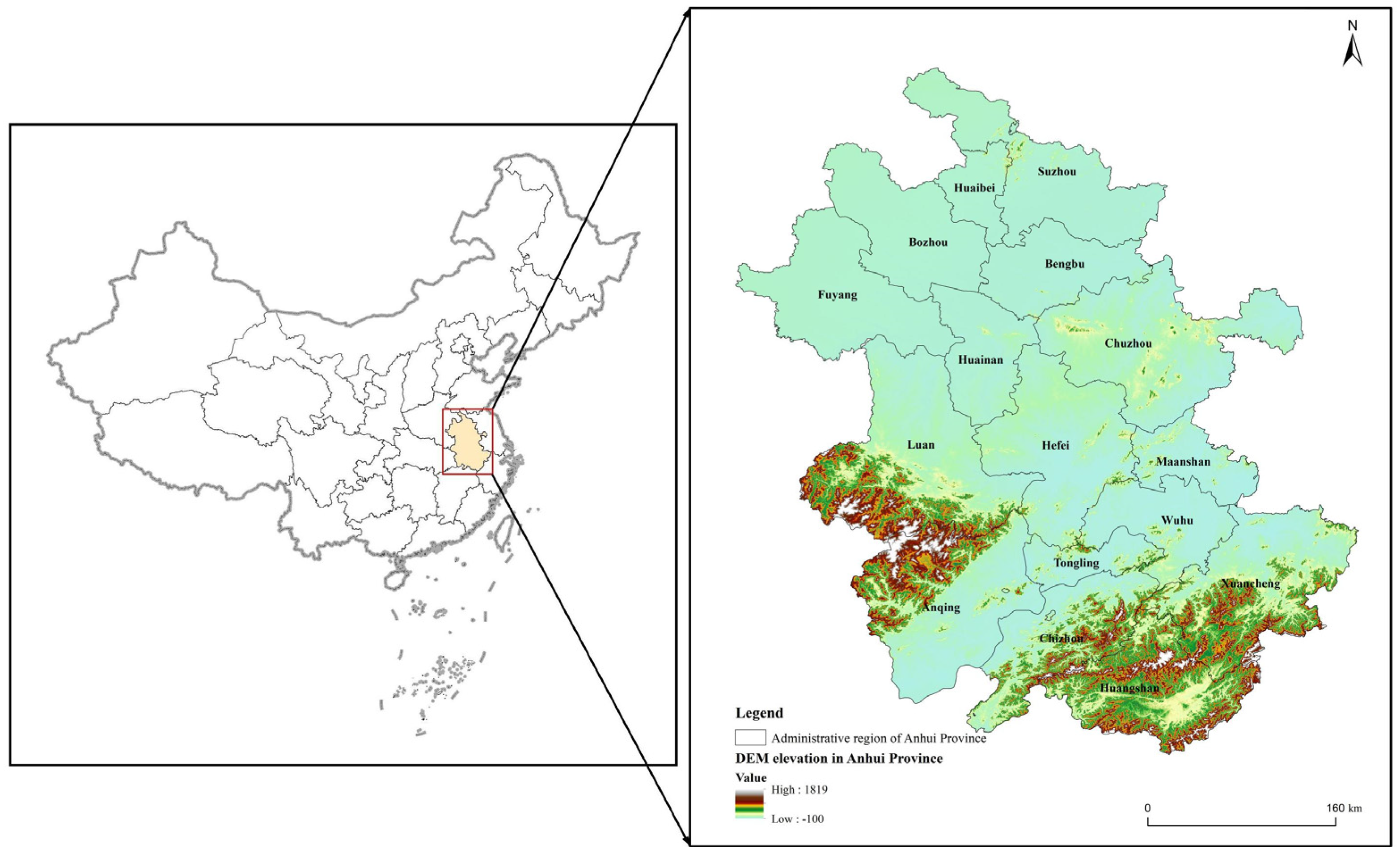
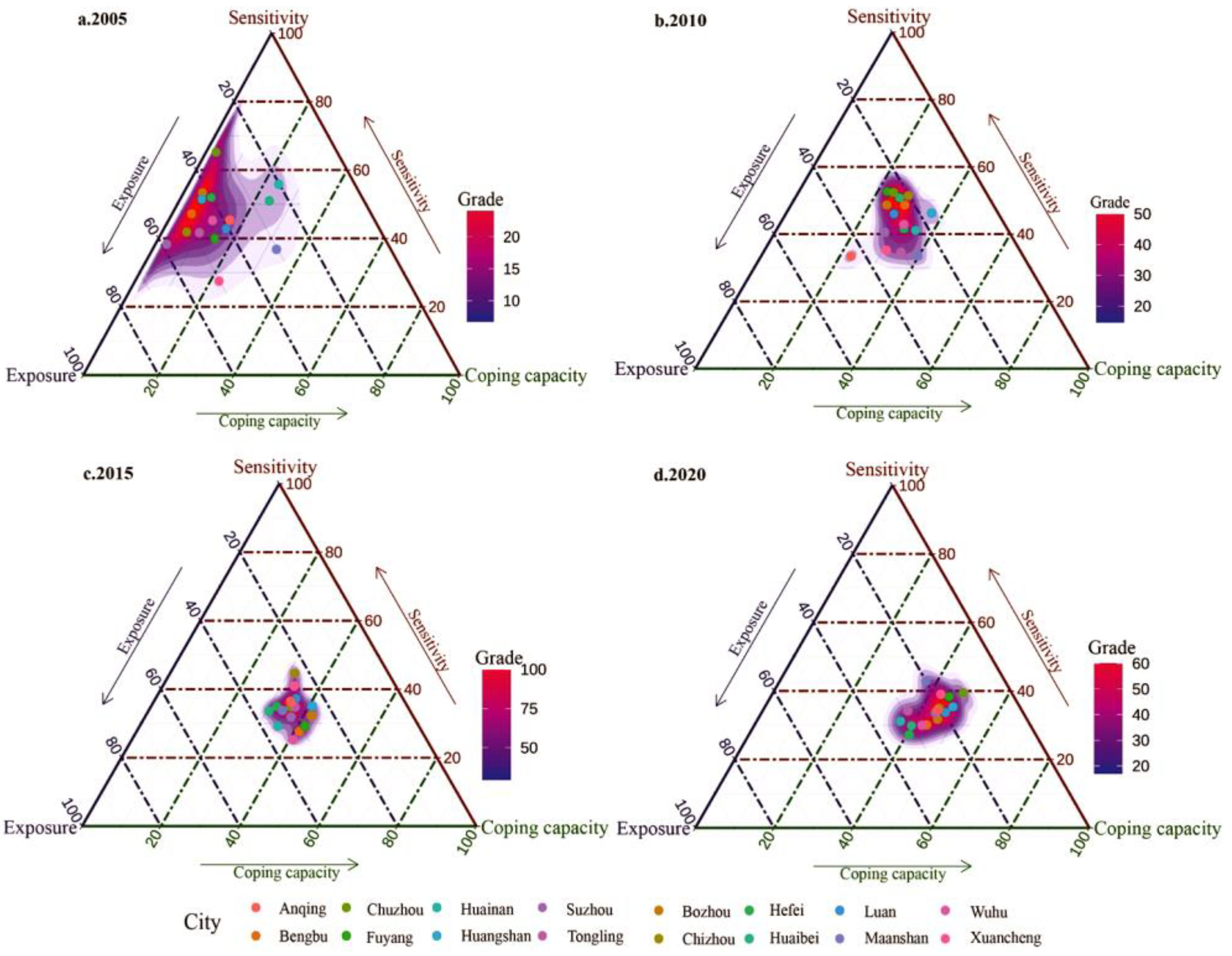

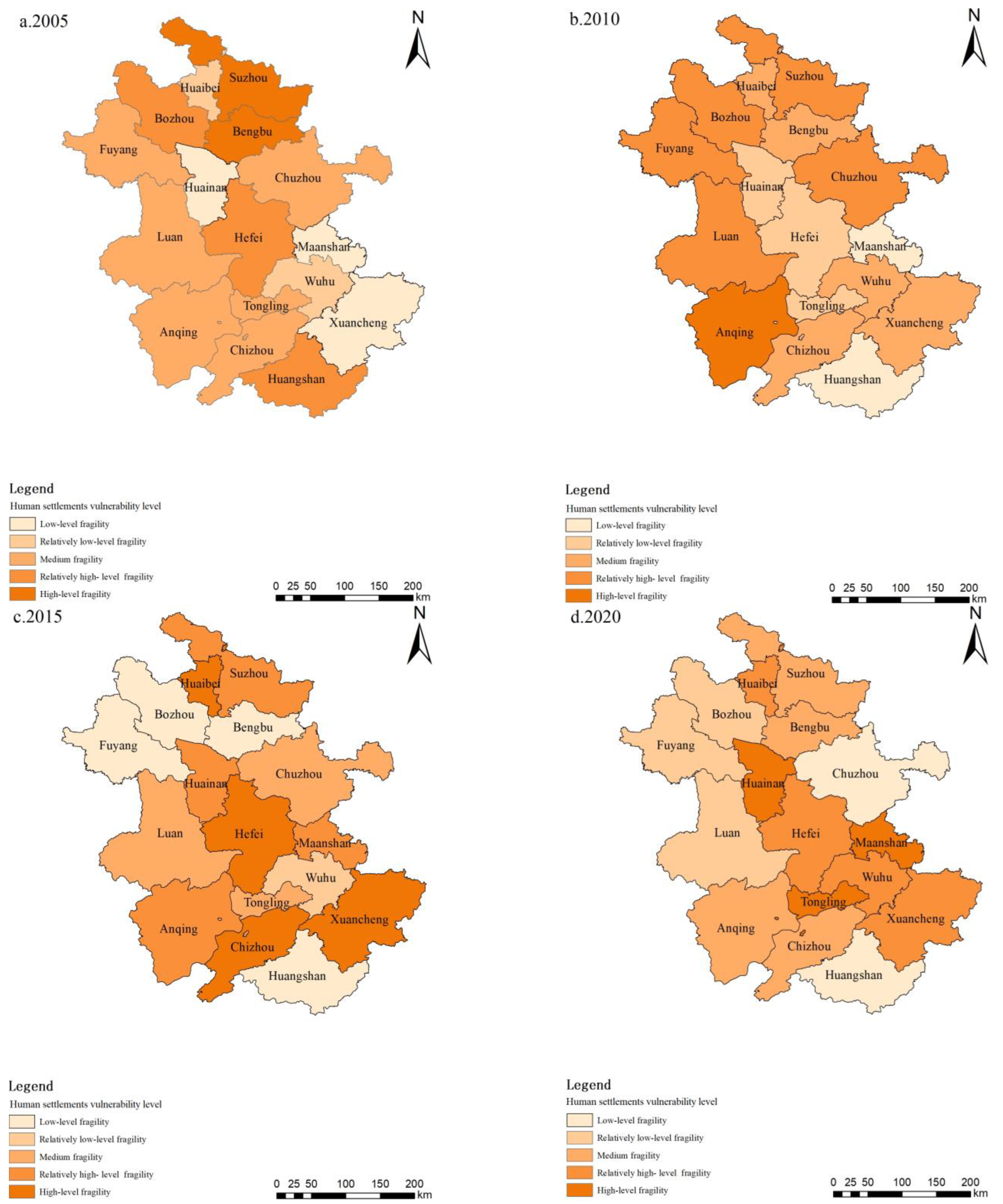
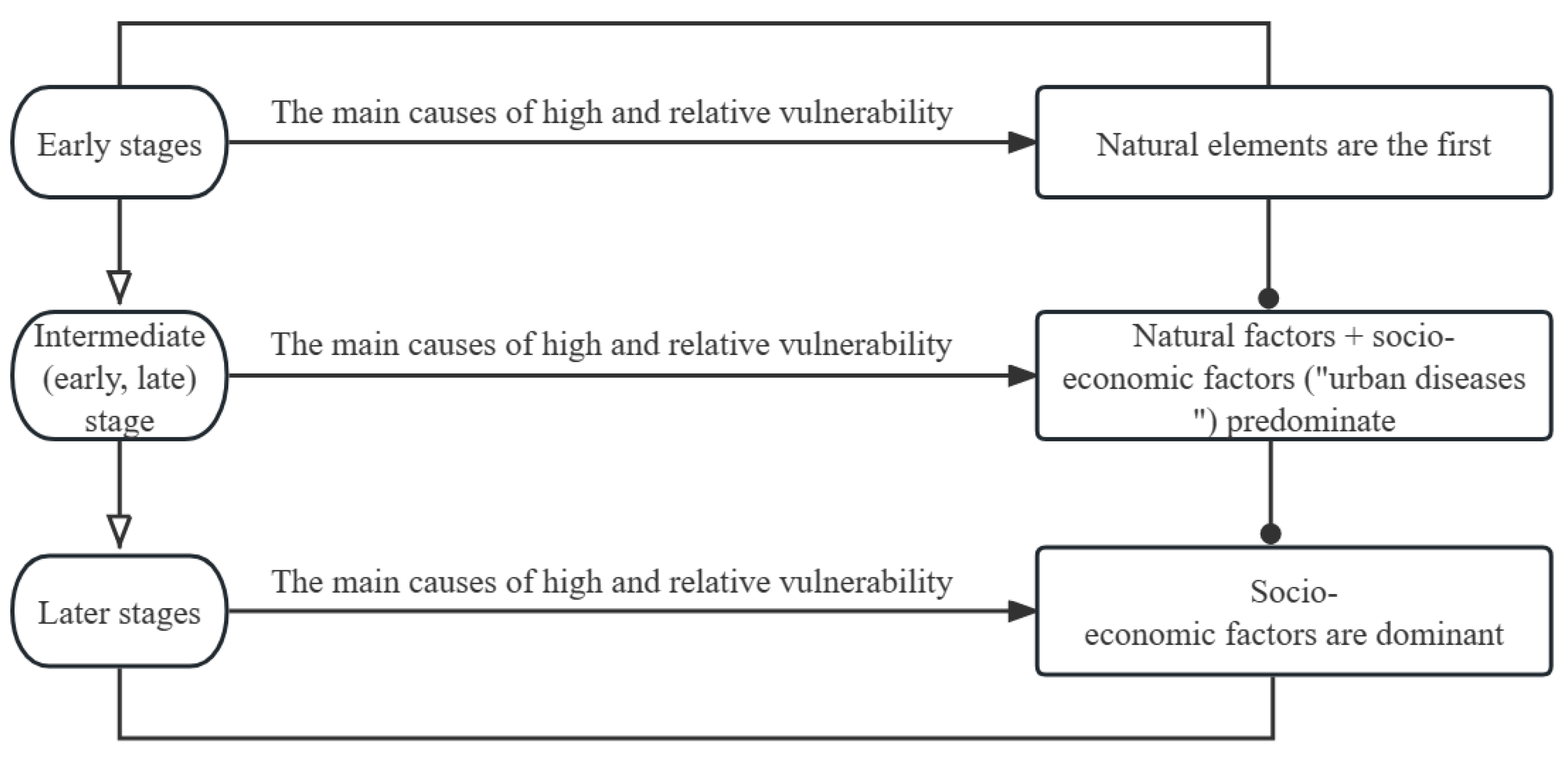
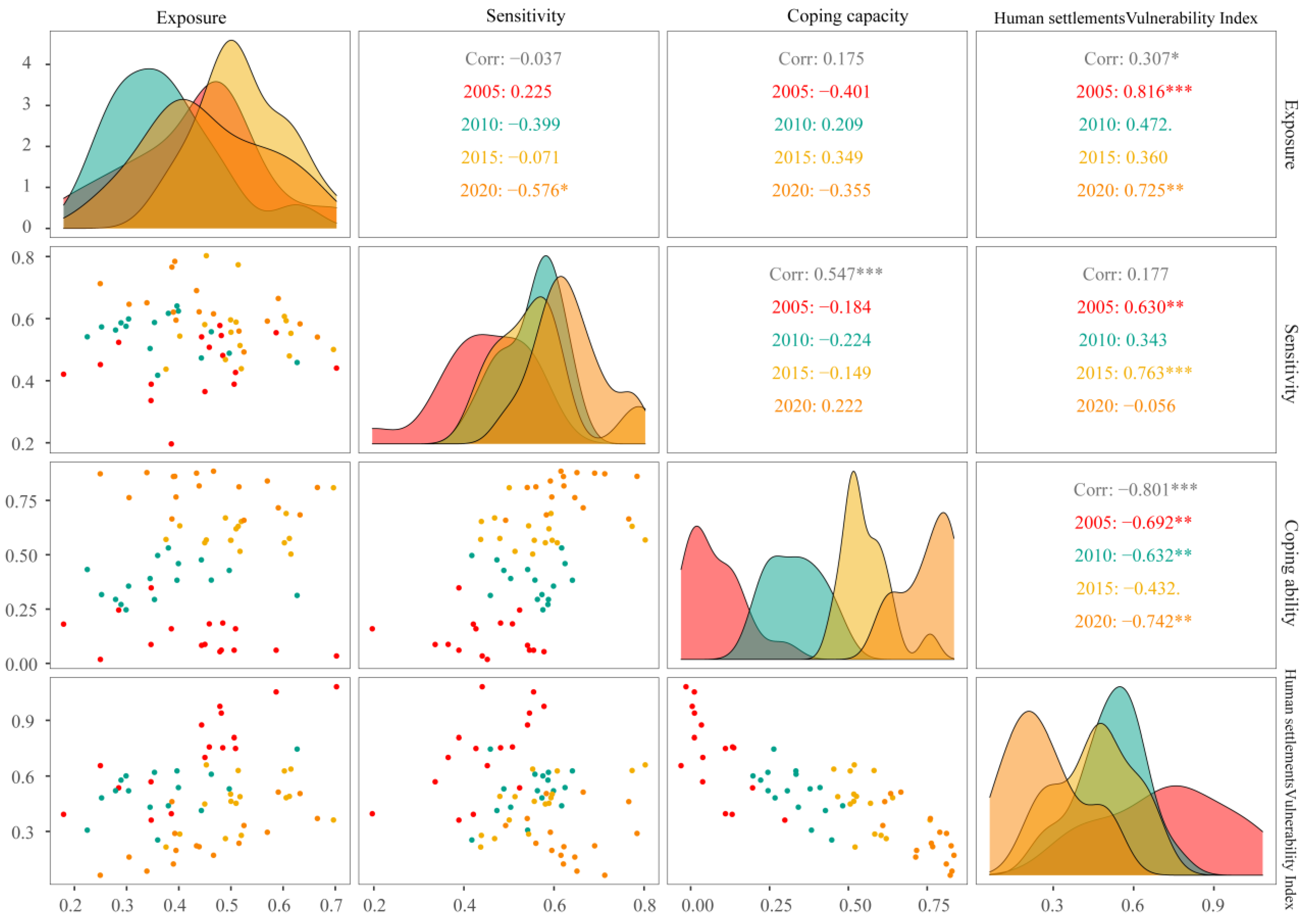
| Functional Layer | Subsystem Layer | Weight Value | Specific Indicators (Units) | Weight Value | Direction |
|---|---|---|---|---|---|
| Urban human settlement vulnerability | Exposure | 0.3303 | Per capita daily domestic water consumption X1 (liter) | 0.1324 | + |
| Non-point source pollution index of farmland X2 | 0.1271 | − | |||
| Number of traffic accidents X3 (rise) | 0.1165 | − | |||
| Mean noise X4 | 0.1402 | − | |||
| Population fire incidence X5 (1/100,000 people) | 0.12 | − | |||
| Total industrial exhaust emissions X6 (10,000 standard cubic meters) | 0.121 | − | |||
| Total industrial wastewater discharge X7 (10,000 tons) | 0.1246 | − | |||
| Industrial solid waste generation X8 (10,000 tons) | 0.1181 | − | |||
| Sensitivity | 0.3336 | Annual temperature and humidity index X9 | 0.1118 | + | |
| The number of days with air quality of or better than level 2 X10 (days) | 0.1539 | + | |||
| Green coverage rate of built-up area X11 (%) | 0.1115 | + | |||
| Urban population density X12 (people/km2) | 0.1325 | − | |||
| Highway density X13 (km/10,000) | 0.1042 | − | |||
| Degree of land use development X14 | 0.1226 | − | |||
| Landscape sensitivity index X15 | 0.1335 | − | |||
| Plaque density X16 | 0.13 | − | |||
| Coping ability | 0.3361 | GDP per capita X17 (RMB/person) | 0.0651 | + | |
| Eligible area for afforestation in that year X18 (hectares) | 0.1078 | + | |||
| Urban municipal public facility construction fixed-asset investment X19 (million CNY) | 0.1041 | + | |||
| Road area per capita x20 (sqm) | 0.0868 | + | |||
| Wastewater treatment rate X21 (%) | 0.0951 | + | |||
| Park green area per capita X22 (sqm) | 0.0766 | + | |||
| Number of urban community service facilities x23 (pcs) | 0.1193 | + | |||
| Urban water supply daily comprehensive production capacity X24 (10,000 cubic meters/day) | 0.1551 | + | |||
| Urban piped water penetration rate X25% (%) | 0.0948 | + | |||
| Urban sanitation latrine penetration rate X26 (%) | 0.0954 | + |
| Indicator Factor | 2005 | 2010 | 2015 | 2020 | |
|---|---|---|---|---|---|
| Exposure | Per capita daily domestic water consumption X1 (liter) | 0.287 | 0.356 | 0.130 | 0.191 |
| Non-point source pollution index of farmland X2 | 0.224 | 0.199 | 0.403 | 0.453 | |
| Number of traffic accidents X3 (rise) | 0.352 | 0.445 | 0.208 | 0.281 | |
| Mean noise X4 | 0.213 | 0.186 | 0.273 | 0.204 | |
| Population fire incidence X5 (1/100,000 people) | 0.457 | 0.222 | 0.615 | 0.407 | |
| Total industrial exhaust emissions X6 (10,000 standard cubic meters) | 0.328 | 0.360 | 0.496 | 0.553 | |
| Total industrial wastewater discharge X7 (10,000 tons) | 0.544 | 0.061 | 0.213 | 0.386 | |
| Industrial solid waste generation X8 (10,000 tons) | 0.145 | 0.538 | 0.276 | 0.624 | |
| Sensitivity | Annual temperature and humidity index X9 | 0.278 | 0.349 | 0.390 | 0.326 |
| The number of days with air quality of or better than level 2 X10 (days) | 0.270 | 0.081 | 0.072 | 0.288 | |
| Green coverage rate of built-up area X11 (%) | 0.516 | 0.397 | 0.677 | 0.340 | |
| Urban population density X12 (people/km2) | 0.409 | 0.245 | 0.115 | 0.340 | |
| Highway density X13 (km/10,000) | 0.298 | 0.346 | 0.120 | 0.407 | |
| Degree of land use development X14 | 0.097 | 0.526 | 0.136 | 0.339 | |
| Landscape sensitivity index X15 | 0.393 | 0.334 | 0.339 | 0.302 | |
| Plaque density X16 | 0.156 | 0.266 | 0.456 | 0.503 | |
| Coping ability | GDP per capita X17 (RMB/person) | 0.257 | 0.598 | 0.384 | 0.476 |
| Eligible area for afforestation in that year X18 (hectares) | 0.567 | 0.499 | 0.179 | 0.478 | |
| Urban municipal public facilities construction fixed-asset investment X19 (million CNY) | 0.178 | 0.313 | 0.236 | 0.210 | |
| Road area per capita x20 (sqm) | 0.343 | 0.083 | 0.359 | 0.405 | |
| Wastewater treatment rate X21 (%) | 0.221 | 0.222 | 0.158 | 0.075 | |
| Park green area per capita X22 (sqm) | 0.076 | 0.332 | 0.216 | 0.372 | |
| Number of urban community service facilities x23 (pcs) | 0.235 | 0.141 | 0.456 | 0.209 | |
| Urban water supply daily comprehensive production capacity X24 (10,000 cubic meters/day) | 0.406 | 0.443 | 0.063 | 0.319 | |
| Urban piped water penetration rate X25% (%) | 0.265 | 0.495 | 0.424 | 0.179 | |
| Urban sanitation latrine penetration rate X26 (%) | 0.488 | 0.154 | 0.315 | 0.145 |
| 2005 A ∩ B | 2010 A ∩ B | 2015 A ∩ B | 2020 A ∩ B | |||||
|---|---|---|---|---|---|---|---|---|
| Exposure | X7 ∩ X1 | BE (0.744) | X8 ∩ X1 | BE (0.788) | X5 ∩ X1 | NE (0.925) | X8 ∩ X1 | BE (0.841) |
| X7 ∩ X2 | BE (0.723) | X8 ∩ X2 | BE (0.765) | X5 ∩ X2 | BE (0.948) | X8 ∩ X2 | BE (0.940) | |
| X7 ∩ X3 | BE (0.744) | X8 ∩ X3 | BE (0.730) | X5 ∩ X3 | BE (0.738) | X8 ∩ X3 | BE (0.917) | |
| X7 ∩ X4 | NE (0.915) | X8 ∩ X4 | NE (0.962) | X5 ∩ X4 | BE (0.778) | X8 ∩ X4 | NE (0.967) | |
| X7 ∩ X5 | BE (0.875) | X8 ∩ X5 | BE (0.775) | X5 ∩ X6 | BE (0.932) | X8 ∩ X5 | BE (0.907) | |
| X7 ∩ X6 | BE (0.809) | X8 ∩ X6 | BE (0.824) | X5 ∩ X7 | BE (0.861) | X8 ∩ X6 | BE (0.879) | |
| X7 ∩ X8 | NE (0.880) | X8 ∩ X7 | BE (0.674) | X5 ∩ X8 | BE (0.842) | X8 ∩ X7 | BE (0.903) | |
| Sensitivity | X11 ∩ X9 | BE (0.746) | X14 ∩ X9 | BE (0.777) | X11 ∩ X9 | BE (0.930) | X16 ∩ X9 | NE (0.998) |
| X11 ∩ X10 | BE (0.771) | X14 ∩ X10 | NE (0.850) | X11 ∩ X10 | NE (0.924) | X16 ∩ X10 | BE (0.652) | |
| X11 ∩ X12 | BE (0.905) | X14 ∩ X11 | BE (0.890) | X11 ∩ X12 | BE (0.848) | X16 ∩ X11 | BE (0.773) | |
| X11 ∩ X13 | BE (0.682) | X14 ∩ X12 | BE (0.699) | X11 ∩ X13 | BE (0.871) | X16 ∩ X12 | BE (0.651) | |
| X11 ∩ X14 | NE (0.828) | X14 ∩ X13 | BE (0.883) | X11 ∩ X14 | BE (0.860) | X16 ∩ X13 | BE (0.769) | |
| X11 ∩ X15 | BE (0.742) | X14 ∩ X15 | BE (0.815) | X11 ∩ X15 | BE (0.877) | X16 ∩ X14 | BE (0.771) | |
| X11 ∩ X16 | NE (0.827) | X14 ∩ X16 | BE (0.840) | X11 ∩ X16 | BE (0.943) | X16 ∩ X15 | BE (0.731) | |
| Coping ability | X18 ∩ X17 | BE (0.858) | X17 ∩ X18 | BE (0.842) | X23 ∩ X17 | NE (0.946) | X18 ∩ X17 | BE (0.953) |
| X18 ∩ X19 | NE (0.943) | X17 ∩ X19 | BE (0.721) | X23 ∩ X18 | NE (0.736) | X18 ∩ X19 | BE (0.687) | |
| X18 ∩ X20 | BE (0.775) | X17 ∩ X20 | NE (0.784) | X23 ∩ X19 | BE (0.626) | X18 ∩ X20 | BE (0.837) | |
| X18 ∩ X21 | BE (0.826) | X17 ∩ X21 | NE (0.938) | X23 ∩ X20 | NE (0.891) | X18 ∩ X21 | NE (0.920) | |
| X18 ∩ X22 | NE (0.822) | X17 ∩ X22 | BE (0.808) | X23 ∩ X21 | NE (0.915) | X18 ∩ X22 | BE (0.825) | |
| X18 ∩ X23 | BE (0.758) | X17 ∩ X23 | NE (0.942) | X23 ∩ X22 | BE (0.708) | X18 ∩ X23 | NE (0.913) | |
| X18 ∩ X24 | BE (0.949) | X17 ∩ X24 | BE (0.862) | X23 ∩ X24 | BE (0.591) | X18 ∩ X24 | BE (0.827) | |
| X18 ∩ X25 | BE (0.903) | X17 ∩ X25 | BE (0.836) | X23 ∩ X25 | BE (0.905) | X18 ∩ X25 | NE (0.934) | |
| X18 ∩ X26 | BE (0.977) | X17 ∩ X26 | NE (0.874) | X23 ∩ X26 | NE (0.882) | X18 ∩ X26 | NE (0.858) | |
Disclaimer/Publisher’s Note: The statements, opinions and data contained in all publications are solely those of the individual author(s) and contributor(s) and not of MDPI and/or the editor(s). MDPI and/or the editor(s) disclaim responsibility for any injury to people or property resulting from any ideas, methods, instructions or products referred to in the content. |
© 2023 by the authors. Licensee MDPI, Basel, Switzerland. This article is an open access article distributed under the terms and conditions of the Creative Commons Attribution (CC BY) license (https://creativecommons.org/licenses/by/4.0/).
Share and Cite
Song, R.; Li, X. Urban Human Settlement Vulnerability Evolution and Mechanisms: The Case of Anhui Province, China. Land 2023, 12, 994. https://doi.org/10.3390/land12050994
Song R, Li X. Urban Human Settlement Vulnerability Evolution and Mechanisms: The Case of Anhui Province, China. Land. 2023; 12(5):994. https://doi.org/10.3390/land12050994
Chicago/Turabian StyleSong, Rui, and Xueming Li. 2023. "Urban Human Settlement Vulnerability Evolution and Mechanisms: The Case of Anhui Province, China" Land 12, no. 5: 994. https://doi.org/10.3390/land12050994
APA StyleSong, R., & Li, X. (2023). Urban Human Settlement Vulnerability Evolution and Mechanisms: The Case of Anhui Province, China. Land, 12(5), 994. https://doi.org/10.3390/land12050994






